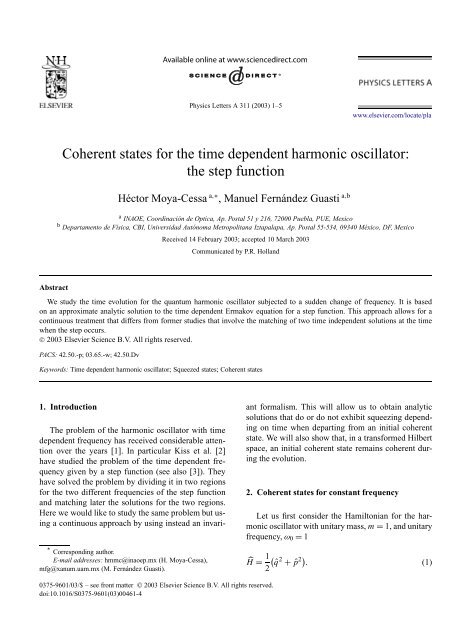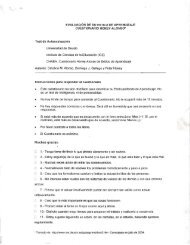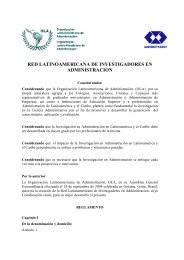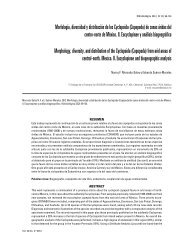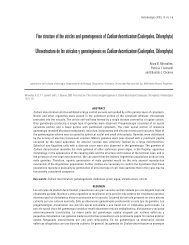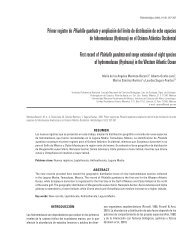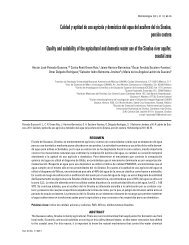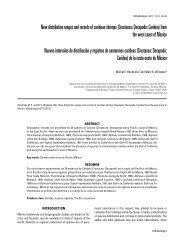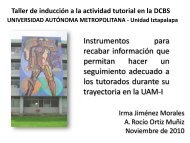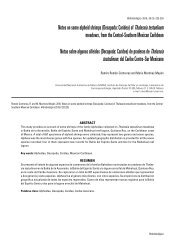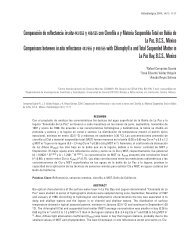Coherent states for the time dependent harmonic oscillator: the step ...
Coherent states for the time dependent harmonic oscillator: the step ...
Coherent states for the time dependent harmonic oscillator: the step ...
You also want an ePaper? Increase the reach of your titles
YUMPU automatically turns print PDFs into web optimized ePapers that Google loves.
Physics Letters A 311 (2003) 1–5<br />
www.elsevier.com/locate/pla<br />
<strong>Coherent</strong> <strong>states</strong> <strong>for</strong> <strong>the</strong> <strong>time</strong> <strong>dependent</strong> <strong>harmonic</strong> <strong>oscillator</strong>:<br />
<strong>the</strong> <strong>step</strong> function<br />
Héctor Moya-Cessa a,∗ , Manuel Fernández Guasti a,b<br />
a INAOE, Coordinación de Optica, Ap. Postal 51 y 216, 72000 Puebla, PUE, Mexico<br />
b Departamento de Física, CBI, Universidad Autónoma Metropolitana Iztapalapa, Ap. Postal 55-534, 09340 México, DF, Mexico<br />
Received 14 February 2003; accepted 10 March 2003<br />
Communicated by P.R. Holland<br />
Abstract<br />
We study <strong>the</strong> <strong>time</strong> evolution <strong>for</strong> <strong>the</strong> quantum <strong>harmonic</strong> <strong>oscillator</strong> subjected to a sudden change of frequency. It is based<br />
on an approximate analytic solution to <strong>the</strong> <strong>time</strong> <strong>dependent</strong> Ermakov equation <strong>for</strong> a <strong>step</strong> function. This approach allows <strong>for</strong> a<br />
continuous treatment that differs from <strong>for</strong>mer studies that involve <strong>the</strong> matching of two <strong>time</strong> in<strong>dependent</strong> solutions at <strong>the</strong> <strong>time</strong><br />
when <strong>the</strong> <strong>step</strong> occurs.<br />
© 2003 Elsevier Science B.V. All rights reserved.<br />
PACS: 42.50.-p; 03.65.-w; 42.50.Dv<br />
Keywords: Time <strong>dependent</strong> <strong>harmonic</strong> <strong>oscillator</strong>; Squeezed <strong>states</strong>; <strong>Coherent</strong> <strong>states</strong><br />
1. Introduction<br />
The problem of <strong>the</strong> <strong>harmonic</strong> <strong>oscillator</strong> with <strong>time</strong><br />
<strong>dependent</strong> frequency has received considerable attention<br />
over <strong>the</strong> years [1]. In particular Kiss et al. [2]<br />
have studied <strong>the</strong> problem of <strong>the</strong> <strong>time</strong> <strong>dependent</strong> frequency<br />
given by a <strong>step</strong> function (see also [3]). They<br />
have solved <strong>the</strong> problem by dividing it in two regions<br />
<strong>for</strong> <strong>the</strong> two different frequencies of <strong>the</strong> <strong>step</strong> function<br />
and matching later <strong>the</strong> solutions <strong>for</strong> <strong>the</strong> two regions.<br />
Here we would like to study <strong>the</strong> same problem but using<br />
a continuous approach by using instead an invari-<br />
ant <strong>for</strong>malism. This will allow us to obtain analytic<br />
solutions that do or do not exhibit squeezing depending<br />
on <strong>time</strong> when departing from an initial coherent<br />
state. We will also show that, in a trans<strong>for</strong>med Hilbert<br />
space, an initial coherent state remains coherent during<br />
<strong>the</strong> evolution.<br />
2. <strong>Coherent</strong> <strong>states</strong> <strong>for</strong> constant frequency<br />
Let us first consider <strong>the</strong> Hamiltonian <strong>for</strong> <strong>the</strong> <strong>harmonic</strong><br />
<strong>oscillator</strong> with unitary mass, m = 1, and unitary<br />
frequency, ω 0 = 1<br />
* Corresponding author.<br />
E-mail addresses: hmmc@inaoep.mx (H. Moya-Cessa),<br />
mfg@xanum.uam.mx (M. Fernández Guasti).<br />
Ĥ = 1 2(<br />
ˆq 2 +ˆp 2) .<br />
(1)<br />
0375-9601/03/$ – see front matter © 2003 Elsevier Science B.V. All rights reserved.<br />
doi:10.1016/S0375-9601(03)00461-4
2 H. Moya-Cessa, M. Fernández Guasti / Physics Letters A 311 (2003) 1–5<br />
We can define annihilation and creation operators as<br />
ˆb = 1 √<br />
2<br />
( ˆq + i ˆp),<br />
ˆb † = 1 √<br />
2<br />
( ˆq − i ˆp),<br />
(2)<br />
such that we can rewrite <strong>the</strong> Hamiltonian as (we set<br />
¯h = 1)<br />
(<br />
Ĥ = ˆb † ˆb + 1 ) (<br />
= ˆn + 1 )<br />
.<br />
(3)<br />
2 2<br />
Eigen<strong>states</strong> <strong>for</strong> <strong>the</strong> Hamiltonian (3) are called Fock or<br />
number <strong>states</strong>:<br />
(<br />
Ĥ |n〉= n + 1 2<br />
)<br />
|n〉.<br />
(4)<br />
Fock <strong>states</strong> are orthonormal and <strong>for</strong>m a complete basis,<br />
such that any o<strong>the</strong>r state of <strong>the</strong> <strong>harmonic</strong> <strong>oscillator</strong><br />
may be written in terms of <strong>the</strong>m. In particular coherent<br />
<strong>states</strong> may be written as<br />
|α〉=e − |α|2<br />
2<br />
∞∑<br />
n=0<br />
α n<br />
√<br />
n!<br />
|n〉=̂D(α)|0〉,<br />
(5)<br />
where<br />
̂D(α) = e α ˆb † −α ∗ ˆb .<br />
(6)<br />
<strong>Coherent</strong> <strong>states</strong> are eigen<strong>states</strong> of <strong>the</strong> annihilation<br />
operator<br />
ˆb|α〉=α|α〉,<br />
(7)<br />
and have <strong>the</strong> property that <strong>the</strong> motion of <strong>the</strong> center of<br />
mass of <strong>the</strong> wave packet obeys <strong>the</strong> laws of classical<br />
mechanics (see, <strong>for</strong> instance [8])<br />
〈α|ˆq|α〉=q c , 〈α| ˆp|α〉=p c ,<br />
〈α|Ĥ |α〉=H c ,<br />
where <strong>the</strong> index c labels <strong>the</strong> classical variables.<br />
3. Time <strong>dependent</strong> <strong>harmonic</strong> Hamiltonian<br />
The <strong>time</strong> <strong>dependent</strong> <strong>harmonic</strong> Hamiltonian reads<br />
Ĥ t = 1 2[<br />
ˆp 2 + Ω 2 (t) ˆq 2] .<br />
(8)<br />
(9)<br />
It is well known that an invariant <strong>for</strong> this type of<br />
interaction has <strong>the</strong> <strong>for</strong>m<br />
I ˆ = 1 [( ) ˆq 2 ]<br />
+ (ρ ˆp −˙ρ ˆq) 2 ,<br />
(10)<br />
2 ρ<br />
where ρ obeys <strong>the</strong> Ermakov equation<br />
¨ρ + Ω 2 ρ = ρ −3 .<br />
(11)<br />
Fur<strong>the</strong>rmore, it is easy to show that Î may be related<br />
to <strong>the</strong> Hamiltonian (1) by a unitary trans<strong>for</strong>mation of<br />
<strong>the</strong> <strong>for</strong>m<br />
̂T = ρ i (<br />
2 ˆq ˆp+ ˆp ˆq+<br />
2ρ ˙ρ<br />
ρ 2 −1 ˆq2) ,<br />
(12)<br />
that can be re-written as (see Appendix A)<br />
̂T = e i ln(ρ)<br />
2 ( ˆq ˆp+ ˆp ˆq) ˙ρ<br />
−i<br />
e 2ρ ˆq2 = e i lnρ d ˆq 2<br />
2 dt e −i ˙ρ 2ρ ˆq2 ,<br />
so that<br />
Ĥ = ̂T ˆ I ̂T † .<br />
By using Eq. (4) we can see that<br />
(<br />
Î ̂T † |n〉= n + 1 )<br />
̂T † |n〉,<br />
2<br />
i.e., <strong>states</strong> of <strong>the</strong> <strong>for</strong>m<br />
(13)<br />
(14)<br />
(15)<br />
|n〉 t = ̂T † |n〉,<br />
(16)<br />
are eigen<strong>states</strong> of <strong>the</strong> so-called Ermakov–Lewis invariant.<br />
Lewis [4] wrote this invariant in terms of annihilation<br />
and creation operators<br />
Î =â † â + 1 2 =ˆn t + 1 2 ,<br />
with<br />
â = 1 √<br />
2<br />
[ ˆq<br />
ρ + i(ρ ˆp −˙ρ ˆq) ],<br />
â † = 1 √<br />
2<br />
[ ˆq<br />
ρ − i(ρ ˆp −˙ρ ˆq) ].<br />
(17)<br />
(18)<br />
Once <strong>the</strong> creation and annihilation operators are defined,<br />
analogous equations to <strong>the</strong> <strong>harmonic</strong> <strong>oscillator</strong><br />
with constant frequency may be obtained <strong>for</strong> <strong>the</strong><br />
TDHO. For instance,<br />
̂D t (α) = e α↠−α ∗â,<br />
(19)<br />
and<br />
â|α〉 t = α|α〉 t ,<br />
with<br />
∞∑<br />
|α〉 t = e − |α|2 α n<br />
2 √ |n〉 t = ̂D t (α)|0〉 t .<br />
n!<br />
n=0<br />
(20)<br />
(21)
H. Moya-Cessa, M. Fernández Guasti / Physics Letters A 311 (2003) 1–5 3<br />
Recently it has been shown that <strong>the</strong> Schrödinger<br />
equation <strong>for</strong> <strong>the</strong> <strong>time</strong> <strong>dependent</strong> <strong>harmonic</strong> Hamiltonian<br />
has a solution of <strong>the</strong> <strong>for</strong>m [5]<br />
∣<br />
∣ψ(t) 〉 = e −iÎ ∫ t<br />
ω(t)dt̂T †̂T(0) ∣ 0 ∣ψ(0) 〉 ,<br />
(22)<br />
with ω(t) = 1/ρ 2 . If we consider <strong>the</strong> initial state to be<br />
〉<br />
∣ ψ(0) = ̂T † (0)|α〉=|α〉 0 ,<br />
(23)<br />
with α given in (5), we note that <strong>the</strong> evolved state has<br />
<strong>the</strong> <strong>for</strong>m<br />
∣<br />
∣ψ(t) 〉 = ̂T †∣ ∣αe −i ∫ t<br />
0 ω(t′ )dt ′ 〉 ∣<br />
= αe −i ∫ t<br />
0 ω(t′ )dt ′ (24)<br />
〉t ,<br />
this is, coherent <strong>states</strong> keep <strong>the</strong>ir <strong>for</strong>m through evolution.<br />
4. Minimum uncertainty <strong>states</strong><br />
We define <strong>the</strong> operators<br />
̂Q = 1 √<br />
2<br />
(â<br />
+â<br />
† ) ,<br />
(25)<br />
and<br />
̂P = 1<br />
(26)<br />
i √ (â −â<br />
† ) .<br />
2<br />
It is easy to see that <strong>the</strong>y are related to ˆq and ˆp by <strong>the</strong><br />
trans<strong>for</strong>mations<br />
ˆq = ̂T ̂Q̂T † ,<br />
and<br />
ˆp = ̂T ̂P ̂T † ,<br />
and that <strong>the</strong>y obey <strong>the</strong> equations [7]<br />
(27)<br />
(28)<br />
5. Step function<br />
Let us consider <strong>the</strong> Hamiltonian of <strong>the</strong> system to be<br />
given by Eq. (9) with Ω(t) given by a <strong>step</strong> function<br />
that may be modeled by [6]<br />
[<br />
Ω(t)= ω 1 1 + (<br />
1 + 1 (32)<br />
2ω 1 2 tanh[ ɛ(t − t s ) ])] ,<br />
where t s is <strong>the</strong> <strong>time</strong> at which <strong>the</strong> frequency is changed,<br />
= ω 2 − ω 1 with ω 1 and ω 2 <strong>the</strong> initial and final<br />
frequencies, and ɛ is a parameter (ɛ →∞describes<br />
<strong>the</strong> <strong>step</strong> function limit). In Fig. (1) we plot this<br />
function as a function of t <strong>for</strong> ω 1 = 1andω 2 = 2<br />
(solid line) and ω 2 = 3 (dash line). The solution to <strong>the</strong><br />
Ermakov equation (11) <strong>for</strong> this particular <strong>for</strong>m of Ω(t)<br />
is given by [6]<br />
ρ(t) = √ 1 (<br />
( )<br />
1 + ω2 1<br />
2 Ω 2 (t) + 1 − ω2 1<br />
Ω 2 (t)<br />
( ∫ t )) 1/2<br />
× cos 2 Ω(t ′ )dt ′ . (33)<br />
t s<br />
Aplotofρ(t) is given in Fig. 2 <strong>for</strong> <strong>the</strong> same values<br />
given in Fig. 1. We also plot ω(t) = 1/ρ 2 in Fig. 3.<br />
It may be numerically shown that <strong>the</strong> <strong>time</strong> average of<br />
ω(t) from t s to <strong>the</strong> end of <strong>the</strong> first period is 2 <strong>for</strong> <strong>the</strong><br />
solid line and 3 <strong>for</strong> <strong>the</strong> dash line, with ω max = 2 2 <strong>for</strong><br />
<strong>the</strong> solid line and ω max = 3 2 <strong>for</strong> <strong>the</strong> dash line.<br />
˙̂P = iω(t)[Î, ̂P ]=−ω(t)̂Q,<br />
and<br />
(29)<br />
˙̂Q = iω(t)[ I, ˆ ̂Q ]=ω(t)̂P.<br />
(30)<br />
The uncertainty relation <strong>for</strong> operators ̂Q and ̂P <strong>for</strong> <strong>the</strong><br />
coherent state (21) is given by<br />
̂Q ̂P = 1 2 ,<br />
(31)<br />
where ̂X = √ 〈̂X 2 〉−〈̂X〉 2 . (Time <strong>dependent</strong>) <strong>Coherent</strong><br />
<strong>states</strong> are thus minimum uncertainty <strong>states</strong><br />
(MUS), not <strong>for</strong> position and momentum but <strong>for</strong> <strong>the</strong><br />
trans<strong>for</strong>med position and momentum.<br />
Fig. 1. Ω(t) as a function of t <strong>for</strong> ω 1 = 1andω 2 = 2 (solid line)<br />
and ω 2 = 3 (dashed line). ɛ = 20 and t s = 2.
4 H. Moya-Cessa, M. Fernández Guasti / Physics Letters A 311 (2003) 1–5<br />
Let us consider that at <strong>time</strong> t = 0wehave<strong>the</strong><br />
system in <strong>the</strong> initial coherent state (5). From Fig. 2<br />
we can see that ̂T(0) = 1since ˙ρ = 0andlnρ = 0.<br />
There<strong>for</strong>e from (23), |ψ(0)〉=̂T † (0)|α〉=|α〉 0 =|α〉<br />
and from (22) we obtain <strong>the</strong> evolved wave function<br />
〉<br />
∣ ψ(t) = e<br />
−iÎ ∫ t<br />
ω(t)dt̂T 0 † |α〉=̂T †∣ ∣ αe<br />
−i ∫ t<br />
ω(t)dt〉 0 .<br />
(34)<br />
Note that <strong>the</strong> coherent state in <strong>the</strong> above equation is<br />
given in <strong>the</strong> original Hilbert space, i.e., in terms of<br />
number <strong>states</strong> given in (4). From Fig. 2 we can also see<br />
that <strong>for</strong> <strong>the</strong> maxima, ˙ρ(t max ) = 0andlnρ(t max ) = 0,<br />
<strong>the</strong>re<strong>for</strong>e ̂T † (t max ) = 1and<br />
∣ ψ(tmax ) 〉 = ∣ αe<br />
−i ∫ tmax<br />
0 ω(t)dt 〉 ,<br />
(35)<br />
i.e., we recover <strong>the</strong> initial coherent state. However, <strong>for</strong><br />
<strong>the</strong> minima, we have ˙ρ(t min ) = 0andlnρ(t min ) ≠ 0<br />
and <strong>the</strong>n we obtain<br />
∣ ψ(tmin ) 〉 = e i ln ρ(t min )<br />
2 ( ˆq ˆp+ ˆp ˆq) ∣ αe<br />
−i ∫ t min<br />
0 ω(t)dt 〉 , (36)<br />
that may be written in terms of annihilation and<br />
creation operators as<br />
∣ ψ(tmin ) 〉 = e lnρ(t min )<br />
2 ( ˆb 2 −( ˆb † ) 2 ) ∣ αe<br />
−i ∫ t min<br />
0 ω(t)dt 〉 , (37)<br />
that are <strong>the</strong> well-known squeezed (two-photon coherent)<br />
<strong>states</strong> [10]<br />
∣ ψ(tmin ) 〉 = ∣ αe<br />
−i ∫ t min<br />
0 ω(t)dt ; ln ρ(t min ) 〉 . (38)<br />
Squeezed <strong>states</strong>, just as coherent <strong>states</strong>, are also MUS.<br />
However <strong>the</strong> uncertainties <strong>for</strong> ˆq and ˆp are<br />
ˆq =<br />
1<br />
√<br />
2 ρ(tmin ) ,<br />
(39)<br />
and<br />
ˆp = ρ(t min)<br />
√<br />
2<br />
.<br />
(40)<br />
Fig. 2. ρ(t) as a function of t <strong>for</strong> ω 1 = 1andω 2 = 2 (solid line) and<br />
ω 2 = 3 (dashed line). ɛ = 20 and t s = 2.<br />
For <strong>time</strong>s in between we will have nei<strong>the</strong>r coherent<br />
<strong>states</strong> nor standard squeezed <strong>states</strong> (in <strong>the</strong> initial<br />
Hilbert space), but <strong>the</strong> wave function<br />
〉<br />
∣ ψ(t) = e<br />
−i ˙ρ ˆq2∣ 2ρ ∣ αe<br />
−i ∫ t<br />
0 ω(t′ )dt ′ ; ln ρ 〉 . (41)<br />
It should be stressed however, that in <strong>the</strong> instantaneous<br />
Hilbert space we will always have <strong>the</strong> coherent<br />
state (24).<br />
6. Conclusions<br />
Fig. 3. ω(t) as a function of t <strong>for</strong> ω 1 = 1andω 2 = 2 (solid line) and<br />
ω 2 = 3 (dashed line). ɛ = 20 and t s = 2.<br />
We have studied <strong>the</strong> problem of <strong>the</strong> <strong>time</strong> <strong>dependent</strong><br />
<strong>harmonic</strong> <strong>oscillator</strong> <strong>for</strong> a particular <strong>for</strong>m of <strong>time</strong> dependency,<br />
namely <strong>the</strong> <strong>step</strong> function. We have studied<br />
it from an invariant point of view that has made it possible<br />
to obtain analytic solutions. We have shown that,<br />
depending on <strong>the</strong> space we look at <strong>the</strong> solutions <strong>for</strong><br />
an initial coherent state, <strong>the</strong> state remains coherent or<br />
it may present squeezing. This squeezing may be enhanced<br />
by increasing <strong>the</strong> frequency difference of <strong>the</strong><br />
<strong>step</strong>.
H. Moya-Cessa, M. Fernández Guasti / Physics Letters A 311 (2003) 1–5 5<br />
Appendix A<br />
The unitary operator ̂T is given by<br />
̂T = ρ i 2ρ ˙ρ<br />
2 ( ˆq ˆp+ˆp ˆq+<br />
ρ 2 −1 ˆq2 ) i ln ρ<br />
2ρ ˙ρ<br />
= e<br />
2 ( ˆq ˆp+ˆp ˆq+<br />
ρ 2 −1 ˆq2 )<br />
. (A.1)<br />
This exponential involves <strong>the</strong> sum of <strong>the</strong> operators<br />
 = i ln ρ ( ˆq ˆp +ˆp ˆq),<br />
2<br />
and<br />
̂B = i ln ρ<br />
ρ ˙ρ<br />
ρ 2 − 1 ˆq2 .<br />
One can show that<br />
(A.2)<br />
(A.3)<br />
[Â, ̂B]=2lnρ ̂B.<br />
(A.4)<br />
Using <strong>the</strong> fact that <strong>the</strong> commutator of <strong>the</strong> two operators<br />
is proportional to one of <strong>the</strong> operators, we can factor<br />
<strong>the</strong> exponential in <strong>the</strong> <strong>for</strong>m (see <strong>for</strong> instance [9])<br />
e i ln ρ<br />
2ρ ˙ρ<br />
2 ( ˆq ˆp+ ˆp ˆq+<br />
1−ρ 2 ˆq2 )<br />
= e<br />
i ln ρ<br />
2 ( ˆq ˆp+ ˆp ˆq) e −i ˙ρ 2ρ ˆq2 .<br />
(A.5)<br />
References<br />
[1] See, <strong>for</strong> instance, V.V. Dodonov, V.I. Man’ko, Phys. Rev. A 20<br />
(1979) 550;<br />
J. Janszky, Y.Y. Yushin, Opt. Commun. 59 (1986) 151;<br />
J.R. Ray, J.L. Reid, Phys. Rev. A 26 (2) (1982) 1042;<br />
F. Haas, J. Goedert, Phys. Lett. A 279 (2001) 181;<br />
S. Bouquet, H.R. Lewis, J. Math. Phys. 37 (11) (1996) 5509.<br />
[2] T. Kiss, J. Janszky, P. Adam, Phys. Rev. A 49 (1994) 4935.<br />
[3] G.S. Agarwal, S.A. Kumar, Phys. Rev. Lett. 67 (1991) 3665.<br />
[4] H.R. Lewis, Phys. Rev. Lett. 18 (1967) 510.<br />
[5] M. Fernández Guasti, H. Moya-Cessa, J. Phys. 36 (2003) 2069.<br />
[6] M. Fernández Guasti, unpublished.<br />
[7] M. Fernández Guasti, H. Moya-Cessa, quant-ph/0212073.<br />
[8] P. Meystre, M. Sargent III, Elements of Quantum Optics,<br />
Springer, Berlin, 1990.<br />
[9] H. Moya-Cessa, J.A. Roversi, S.M. Dutra, A. Vidiella-<br />
Barranco, Phys. Rev. A 60 (1999) 4029.<br />
[10] H.P. Yuen, Phys. Rev. A 13 (1976) 2226.


